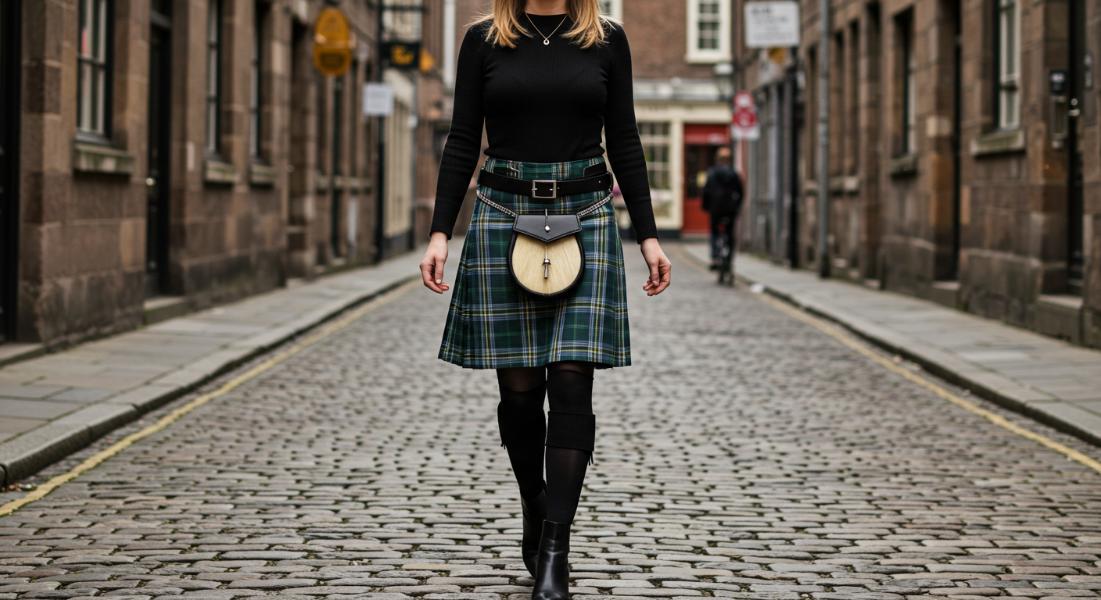How to Care for Your Women’s Irish Kilt: Maintenance Tips

Kilts have a long history, deeply intertwined with Irish and Scottish culture, and wearing one is a true expression of tradition and pride. However, like any cherished garment, your Irish kilts for women deserves the proper care to preserve its beauty, structure, and longevity. Each fabric requires specific maintenance techniques, whether made of wool, cotton, velvet, or synthetic materials. This blog will walk you through the best practices for caring for your kilt, ensuring it remains pristine for years.
1. Understanding Your Kilt's Fabric and Material
The first step in caring for your kilt is understanding the fabric it's made from. Different materials have distinct care requirements, so knowing what you're working with is essential for proper maintenance. Designers often make women's Irish kilts from a variety of materials, including:
- Wool: A traditional choice, wool kilts are known for their warmth, durability, and rich texture.
- Polyester Blends: Common for more affordable kilts, polyester is durable, low-maintenance, and easy to care for.
- Cotton: Lightweight and breathable, cotton kilts are great for warmer weather, offering comfort and versatility.
- Velvet: For a more luxurious, formal look, velvet adds an elegant touch to your kilt but requires extra care.
- Tweed: A classic fabric that is both durable and stylish, typically used for casual or outdoor events.
Knowing the fabric of your kilt helps you decide on the appropriate cleaning method, drying techniques, and storage solutions.
2. General Cleaning Tips for Women's Irish Kilts
Regular cleaning is essential to maintain the look and feel of your Irish kilt women. However, not all kilts require frequent washing. Here are some general guidelines to keep in mind:
Spot Cleaning
Spot cleaning is often the best option if your kilt gets a small stain. Dab the affected area with a damp cloth or sponge using a mild detergent or fabric cleaner. Avoid scrubbing, as this can distort the fabric or damage its fibers.
Washing
Not all fabrics can withstand a complete wash. Here's how to approach cleaning based on the material:
- Wool: Since wool is delicate, you should ideally dry-clean it. If you need to wash it, hand wash it with cold water and a mild wool detergent. Always avoid wringing out the fabric, as this can distort the fibers.
- Polyester Blends: These fabrics are more robust and can typically be machine-washed. However, always use a gentle cycle and cold water to prevent shrinking or fading.
- Cotton: Cotton kilts can usually be machine-washed in cold water. Use a mild detergent and avoid hot water to prevent shrinking.
- Velvet: Since velvet is a delicate fabric, you should always dry-clean it to avoid damaging its luxurious texture.
- Tweed: Tweed kilts should be spot-cleaned or dry-cleaned. If you need to wash it, use cold water and a gentle cycle.
Avoid Harsh Chemicals
Avoid using bleach or harsh detergents, as they can break down the fibers, especially on wool and velvet kilts. Always choose a detergent that is gentle and suitable for the specific fabric of your kilt.
3. Drying Your Kilt: Best Practices
Once your kilt is clean, drying it properly is just as important as the washing process. Drying techniques vary based on the fabric, and improper drying can lead to damage.
Avoid the Dryer
Using a clothes dryer is a big no-no for most kilts, particularly wool, velvet, and tweed. The heat can shrink the fabric, cause it to lose shape, or even damage its structure. Always air-dry your kilt to preserve its integrity.
Air Drying
The best way to dry your kilt is by laying it flat or hanging it in a well-ventilated area. If hanging, make sure to use a padded hanger to support the weight of the fabric evenly and prevent it from losing shape. Avoid hanging it by the waistband or using clips that could leave marks or stretch the fabric.
Lay the garment flat on a towel for velvet kilts to prevent the fabric from being crushed. Velvet is particularly sensitive to pressure, and you want to keep the fabric plush.
Drying Wool
Wool kilts should be dried flat to prevent stretching or losing shape. Roll it gently in a towel to remove excess moisture, then lay it flat on a drying rack.
Drying Polyester or Cotton
Polyester blends and cotton are less delicate, and you can hang them to dry. However, avoid direct sunlight for prolonged periods, as it can fade the colors.
4. Ironing and Steaming Your Kilt
Kilts, especially those made of wool or velvet, may require some gentle pressing to keep them looking sharp. Here's how to handle the ironing and steaming process:
Ironing
When ironing a kilt, always check the care label for specific instructions. Use a low to medium heat setting for wool and polyester blends. You should iron wool while still slightly damp to avoid scorching the fabric.
- For Velvet: Never iron velvet directly, as it can crush the fibers and ruin the fabric's luxurious look. Instead, use a steamer or iron with a cloth between the fabric and the heat source.
Steaming
Most people prefer steaming for delicate fabrics, especially velvet and wool. Steaming will help release wrinkles without causing damage and restore some of the fabric's natural sheen.
You can gently hang the kilt and use a garment steamer to remove wrinkles from the wool. This will also help maintain the fabric's structure and prevent it from looking flat.
5. Storing Your Kilt Properly
How you store your kilt is as important as how you clean and dry it. Proper storage prevents unnecessary damage, keeping your kilt in excellent condition.
Storage Environment
Store your kilt in a cool, dry place away from direct sunlight, as prolonged exposure can cause fading and weaken the fabric. Avoid storing your kilt in damp or humid areas, which can lead to mildew growth.
Hanging vs. Folding
For kilts made of heavier fabrics like wool or tweed, it's best to hang them to prevent them from becoming misshapen. Use a padded hanger to support the garment and maintain the pleats. For lighter fabrics like cotton, folding the kilt neatly and storing it in a drawer or closet is okay.
Using Garment Bags
Invest in a breathable garment bag for storage. It will protect your kilt from dust, dirt, and moths, ensuring it remains pristine. Using a garment bag with good ventilation for wool kilts will prevent moth damage, which is a common concern for wool fabrics.
6. Repairing Your Kilt: Fixing Common Issues
No garment is immune to wear and tear; your kilt may need repairs over time. Here are some common issues and how to handle them:
Tears and Rips
If your kilt has a small tear or rip, it's best to repair it as soon as possible to prevent further damage. You can either stitch the tear by hand or take the kilt to a professional tailor for more delicate repairs.
Loose Pleats or Hemlines
Suppose the pleats become loose or the hemline starts to unravel. In that case, it's essential to fix it quickly to avoid further unraveling. You can re-pleat or re-hem the kilt by hand or visit a tailor for a more precise repair.
Replacing Buttons or Clasps
If your kilt has buttons or clasps that have come loose, replacing them is pretty simple. Ensure you use high-quality buttons or clasps that match the style of your kilt.
7. Preventing Wear and Tear
Preventive measures will help your kilt last longer and maintain its original appearance. Here are some tips to minimize wear and tear:
- Proper Fit: Ensure your kilt fits well to prevent undue stress on the fabric, especially around the waist and hips.
- Rotation: If you own multiple kilts, rotate them regularly to reduce wear on any piece.
- Regular Maintenance: Periodically clean and inspect your kilt for any signs of damage and address minor issues before they become more significant problems.
Conclusion
Caring for your Irish woman kilt is about preserving its aesthetic appeal and ensuring it lasts many years. Following these maintenance tips, such as understanding your kilt's fabric, washing it correctly, and storing it properly, will keep your kilt looking as beautiful as the day you bought it. With proper care, your kilt will always be ready to impress, whether for a formal event, a traditional celebration, or a casual outing.
Remember, kilts are an investment in culture and style, so treat them with the respect they deserve, and they will continue to serve you well.


